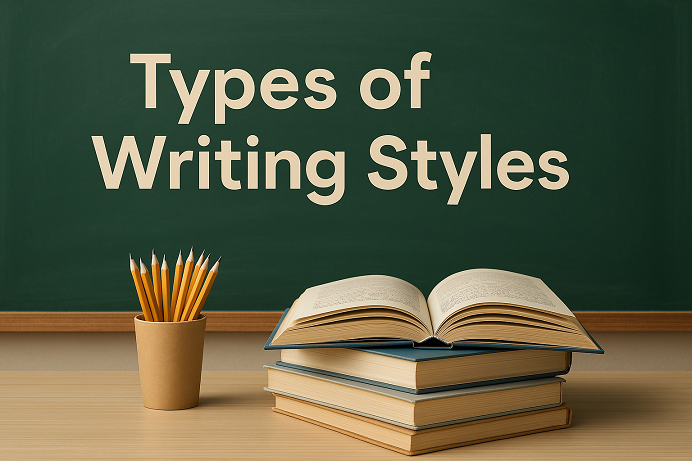Mastering Different Types of Writing Styles: EssayPro’s Guide for Students
College assignments pose many questions for students: What to write? How to write it? Many have experienced the frustration of receiving disappointing grades, accompanied by feedback such as “too vague” or “lacking structure.” This highlights the importance of understanding that each college assignment necessitates a distinct writing style. Mastering these styles is crucial for academic success. This guide, prepared by EssayPro, aims to demystify the complexities of academic writing. It will explore six major writing styles, providing students with the knowledge to discern when to employ each one. By understanding these different kinds of writing, and implementing simple yet effective techniques, students can significantly enhance their writing and achieve academic excellence.
What Is Style in Writing?
The term “writing style” refers to the distinctive manner in which an author articulates their thoughts. It significantly influences the clarity, tone, and overall engagement of the reader. Key elements such as word choice, sentence structure, tone, and voice collectively shape this style. These elements are not static; they vary considerably depending on the writing’s purpose, whether it be academic, creative, or persuasive. Ultimately, style serves to define an author’s unique identity and profoundly impacts how readers interpret and perceive the intended message. To further understand the nuances of effective writing, it is essential to explore the four primary writing styles.
Expository Writing: The Foundation of Academic Work
Expository writing stands as a cornerstone of academic life, representing the most prevalent style encountered in college. When crafting research papers, lab reports, or analytical essays, students are invariably engaging in expository writing. This style is characterized by its focus on presenting facts, elucidating concepts, and maintaining an objective stance devoid of personal opinions. In essence, it serves to answer the fundamental question, “How does this work?”
Common manifestations of expository writing include textbooks, news articles, lab reports, research papers, and informative essays. Its key features encompass a clear and logical structure, an objective tone, and arguments substantiated by evidence. One of the primary challenges students face is adhering to this neutral tone and abstaining from subjective viewpoints. To enhance the logical cohesion of their writing, students are advised to employ transition words such as “therefore,” “in contrast,” and “as a result.” Understanding these types of styles in writing is crucial for academic success, and Essay Pro reviews offer valuable resources for those in need.
Descriptive Writing: Painting Pictures with Words
Imagine immersing oneself in a narrative so vivid that the aroma of brewing coffee and the chill of a morning breeze become almost tangible. This is the essence of descriptive writing. It is a style that emphasizes sensory details, engaging the reader’s sight, hearing, smell, taste, and touch. Common examples of descriptive writing include poetry, short stories, personal journals, and creative essays. Its hallmarks are strong imagery, metaphors, similes, and other forms of figurative language.
One of the challenges students face is finding the delicate balance between insufficient and excessive description. To master this style, it is crucial to “show, don’t tell.” Instead of stating, “It was a sad day,” one might write, “Raindrops slid down the window as she stared at the unopened letter.” Understanding these different ways to write is essential for creating engaging and impactful narratives.
Persuasive Writing: The Art of Convincing
Consider the act of persuading a professor to grant an extension on a deadline; this exemplifies persuasive writing in practice. This style is fundamentally aimed at convincing readers to adopt a specific viewpoint or to undertake a particular action. It achieves this by strategically blending logic, emotional appeals, and credibility to construct a compelling argument. Common examples of persuasive writing include argumentative essays, opinion pieces, cover letters, and advertisements. Its defining features are a clear thesis statement, robust evidence, the acknowledgment of counterarguments, and the employment of rhetorical devices.
Students often encounter the challenge of crafting a convincing argument while maintaining an unbiased tone. A valuable strategy is to utilize the ethos, pathos, and logos framework: establishing credibility (ethos), appealing to the reader’s emotions (pathos), and supporting claims with factual evidence (logos). Recognizing these different types of styles in writing is key to effectively influencing and persuading an audience.
Narrative Writing: The Power of Storytelling
Picture a personal essay that resonates like an intimate conversation; this is the essence of narrative writing. It is a style that conveys a story, whether factual or fictional, employing a structured plot, well-developed characters, and emotional depth.1 Common examples of narrative writing include personal essays, memoirs, creative writing assignments, and blog posts. Its defining characteristics are compelling openings, nuanced character development, engaging dialogue, and a clear narrative arc with a beginning, middle, and end.
Students often face the challenge of crafting a story that captivates the audience while maintaining focus. A highly effective technique is to begin with a hook—an intriguing question, a surprising revelation, or an emotionally charged moment—to immediately capture the reader’s attention.2 Recognizing these different writing styles allows students to tell compelling stories.
Mastering the Craft: A Lifelong Skill
Mastering these four writing styles transcends mere academic achievement; it cultivates superior communication skills. Proficiency in navigating various contexts, from academic assignments to professional applications and online expression, provides a distinct advantage. Students are encouraged to observe the writing styles employed in their assignments, identifying the specific style required. Understanding what are the different types of writing styles is a powerful tool. Ultimately, writing is not solely an academic endeavor but a vital life skill. Consistent practice fosters confidence and effectiveness, empowering individuals to articulate their thoughts with clarity and impact.






